 Description Description Function diagram Function diagram Schematic Schematic Programming Programming Dimensions Dimensions Technical data Technical data Downloads Downloads Link to the successor model Link to the successor model |
||
| New value/First-up indicator LSE | ||
 Important information regarding the LSE new value / First-up indicator
Important information regarding the LSE new value / First-up indicatorDescription
GeneralThe LSE New value/First-up indicator is designed to signalise technical faults according to the DIN 19235 sequence. You may choose between New value or First-up indication. The units are front mounted in a standard cut-out. All electrical connections are realised by plug-in screw terminals on the back of the unit. Therewith, unit changes and mensurations are easily to realise. To build larger systems with a higher amount of inputs than a single device offers, it is possible to connect up to twelve units. The front is equipped with 8 or 16 red alarm LED's and one green LED to indicate the normal condition. In addition to this, buttons for the lamp test, alarm acknowledgement, horn acknowledgement and a buzzer are built in. The acknowledgement and lamp test can also be realised by external buttons. The unit provides one potential free contact (NO) for the audible device / horn and two contacts (NO) for group and common alarm with the same potential. The supply- and signal voltage is available in many different varieties. As an option the units are available with output relays. It is also possible to produce the Common Alarm Indicator without buttons and buzzer or with a time delay for all inputs.
Function
New value indication
Each incoming alarm is indicated by the corresponding visual indicator flashing. At the same time the relay output is activated for an audible alarm (connectors 3 and 4) When the lamp acknowledgement button is pressed, the visual indicator changes from flashing to continuous light, when the alarm still persists. If a further alarm occurs after the horn has been acknowledged but before lamp acknowledgement, the horn remains inactive and the visual indicator flashes until lamp acknowledgement. If the alarm has meanwhile disappeared, the visual indicator goes out. The audible alarm is acknowledged separately.
First-up indication
If several alarms arrive, only the alarm which has occurred first is indicated by flashing light. If the alarm becomes inactive before the lamp is acknowledged, the indicator flashes until the lamp is acknowledged, then it turns off. If another alarm arrives after the horn is acknowledged but before lamp acknowledgement, the horn is reactivated. All other alarms are indicated by continuous light as long as they persist. At the same time the relay output is activated for an audible alarm (connectors 3 and 4).
Common alarm
The function of the common alarm relay can be programmed as followed:
DIP switch 7 off / DIP switch 8 off
DIP switch 7 on / DIP switch 8 off
DIP switch 7 off / DIP switch 8 on
DIP switch 7 on / DIP switch 8 on
Group alarm
The group alarm relay is active as long as a signal input of the own device is active. The relay switches off when all signal inputs of the unit are off.
Lamp test
The lamp test button activates all LED's for about 4 seconds. If several units are connected together the lamp test is overlapping.
Audible device / horn
The internal buzzer and the horn relay are activated by the signal inputs.
The relay stays active until acknowledgement even when the signal inputs went off meanwhile. Acknowledgement is possible with the HQ button or an external switch.
Signal inputs
The signal inputs can be changed in two groups from NO normally open to NC normally closed with the DIP switch No. 3 and 4. Units with 8 signal inputs have two groups of 4 inputs, units with 16 signal inputs have two groups of 8 inputs which can be programmed.
Output relays (optional)
The output relays are connected to the signal input carrying the same number. The function can be programmed with the DIP switches 5 and 6 as followed:
DIP switch 5 off / DIP switch 6 off
DIP switch 5 on / DIP switch 6 off
DIP switch 5 off / DIP switch 6 on
DIP Switch 5 on / DIP Switch 6 on
Function diagram
New value indicator
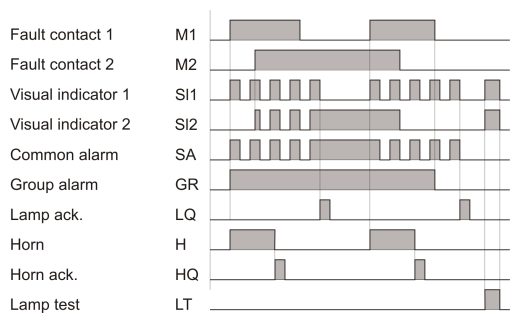
First-up indicator
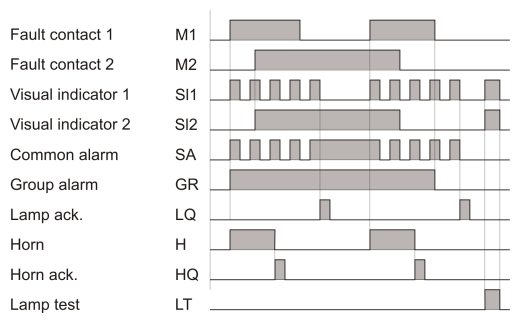
Schematic
Please click on the image for a larger view or go to the download of the wiring diagram sheet
New value/First-up indicator with 8 inputs / LED and external signal voltage
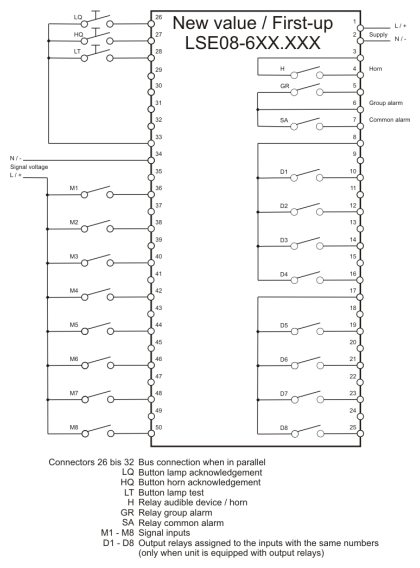
New value/First-up indicator with 16 inputs / LED and external signal voltage
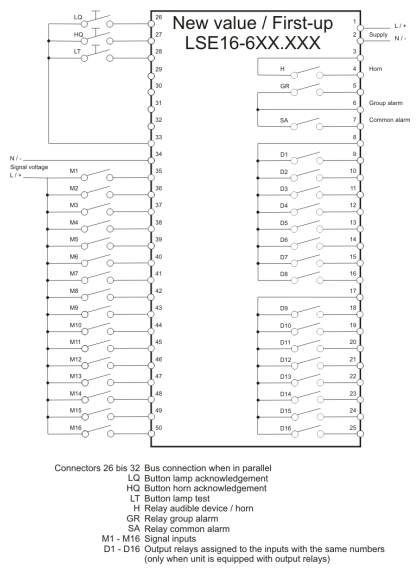
New value/First-up indicator with 8 inputs / LED and internal signal voltage
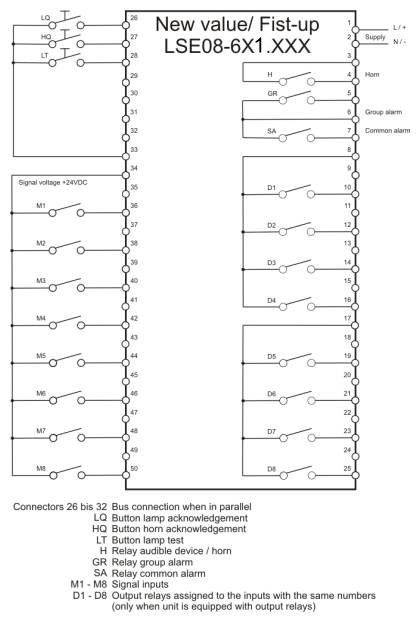
New value/First-up indicator with 16 inputs / LED and external internal voltage
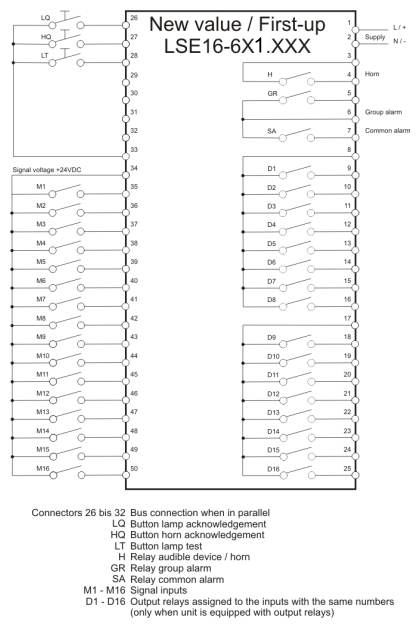
Parallel connection
To build larger systems, it is possible to connect up to twelve units. The alarm acknowledgement, the horn acknowledgement, the lamp test, the common alarm relay and the horn are activated overlapping. The connectors are used as follows:
Connector 26: Alarm acknowledgement (external and overlapping)
Connector 27: Horn acknowledgement (external and overlapping)
Connector 28: Lamp test (external and overlapping)
Connector 29: Synchronisation of the blinking frequency (DIP-switch 2 must be set "on" on one unit, all others "off")
Connector 30: First value signalisation (only when using "first-up" sequence)
Connector 31: Common alarm relay activation
Connector 32: Horn activation
Connector 33: Ground
Programming
The programming of the LSE New value/First-up indicator is effected by a DIP-switch as followed:
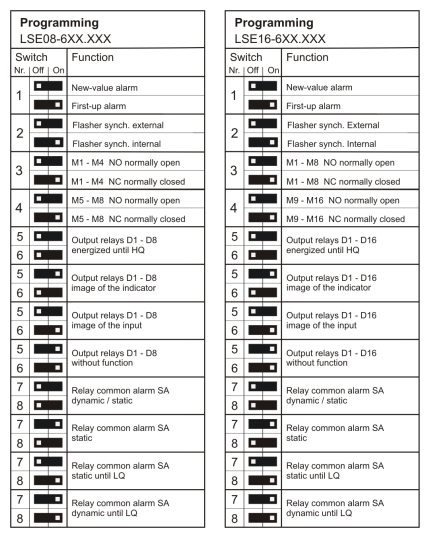
Please note that it is necessary to switch off and on the supply voltage to activate the programm!
Dimensions
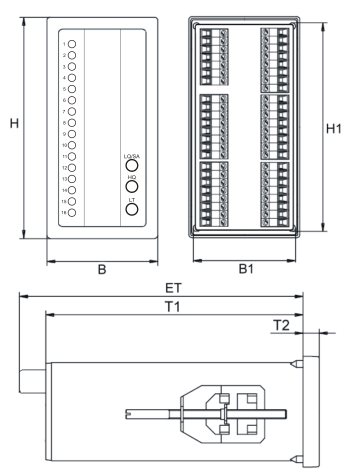
| H | B | H1 | B1 | ET | T1 | T2 |
|---|---|---|---|---|---|---|
| 144 mm | 72 mm | 136 mm | 65 mm | 164 mm | 154 mm | 8.5 mm |
Technical data
| Amount of signal inputs | 8 / 16 | ||||
|---|---|---|---|---|---|
| Type of signal inputs | Changeable between NO/NC in two groups | ||||
| Supply voltage nom. | 24VDC | 24VAC | 60VDC | 110VDC | 230VAC |
| Supply voltage range | 20-30VDC | 22.5-30VAC | 51-78VDC | 93-127VDC | 207-253VAC |
| Power consumption | 6.3W | 6.3VA | 13W | 11W | 11 /VA |
| Frequency (AC units) | 40-60Hz | ||||
| Signal voltage nominal | 24VDC | 24VAC | 60VDC | 110VDC | 230VAC |
| Signal voltage tolerance | 18-30VDC | 18-30VAC | 51-78VDC | 93-127VDC | 170-250VAC |
| LED colours | Red / special colours on request | ||||
| Blink frequency | 2Hz | ||||
| Switching capacity relays H/Gr/Sa | AC:1000VA / DC:300W | ||||
| Switching capacity relays M1-M16 | AC:250VA / DC:125W | ||||
| Ambient temperature | -20 - +65°C | ||||
| Mounting position | Any | ||||
| Protection class | Housing: IP40 / Connectors: IP20 | ||||
| Connectors | Plug-in screw terminals 4mm² (2x1.5mm²) | ||||
| Weight | 800g to 1400g | ||||
| Dimensions WxHxD | 144x72x164mm | ||||
| Front panel cut-out | 138x68mm | ||||
